Marshal Lund and the Two Faced Outlaw
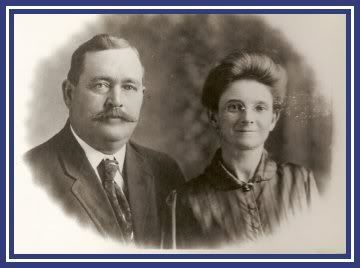
Alfred and second wife, Lizzie
Nowhere in Oklahoma history has a Marshal started and ended his career confronting the same outlaw counterpart. This such thing happened to Marshal Alfred Lund.
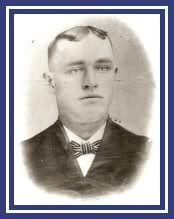
Alfred Lund age 16 |
He was born Alfred Oscar Lund on the 17th day of February 1867 near Leavenworth, Kansas. In 1879, the family sold their farm and moved to a ranch in Chautauqua County, near Wellington where at the age of 15, Alfred took the saddle.
For the next seven years, until he was 22, he herded cattle on the ranch and drove them into Indian territory. While yet a youth, he rode through the sparsely settled and untouched lands of Oklahoma and Texas, until he he took a wife, Ora May Wahl, and settled down at Conway Springs, Kansas.
|
When the opening of the Cherokee Strip came, Alfred wasn't interested in staking a claim, however, he did act as a guide for a group from Iowa. On his way back, he happned onto a site which boasted framed buildings in addition to many tents dotted around. This was the town of Blackwell and the framed buildings were known as A.J. Blackwell's offices.

Newspaper Ad |
|
He soon located his brother-in-law, L.W. Clark, who proposed a business opportunity of opening a livery barn. Alfred agreed, and after contacting his wife, the long task of construction began. On November 29, the Eagle Livery Barn was completed. The result was the most commodious livery and feed stable in town. An office, grainery, well, and stall room for 50 head of horses were all under one roof.
With the livery stable completed, he began construction on his family residence in the 200 hundred block of King David Avenue. By spring of 1894, he accompanied his wife and family to their new home. |
In March of 1894, the position of City Marshal came up for election. Alfred decided to put his name on the list, running under the populist ticket. He was defeated soundly. Thinking City Marshal was a big jump, he ran for Town Constable, but was defeated a second time.
Alfred never gave up his dream of law enforcement.. Someday he might prove to the people of the town that he had what it took to be a territory lawman. On December 4, 1896, that day came.
The day after Thanksgiving Ben Cravens, a one time cattle thief, and his partner Buck McGregg appeared at Blackwell and obtained some supplies while they studied the location of the bank which was run by M.E. Richardson. When the two men rode out of town they headed northeast about 3 ˝ miles to an abandoned one-room shack on the edge of a wooded ravine. There wasn’t a well on the place so Cravens went to the house of a neighbor, Bert Benjamin, for some drinking water. In his conversation with the farmer, he asked several questions about the interior of the Blackwell bank. Benjamin pretended to treat the inquiries casually.
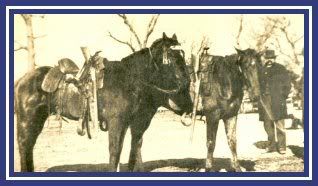
Outlaw's Horses |
|
The next day, after Cravens and McGregg had departed, Benjamin hurried into Blackwell and reported the matter to the Deputy Sheriff J.R. Cox. Cox heard the story and the description of the black horses that Cravens was riding. He was convinced that they were the pair being sought for the robbery in Hewins, Kansas. Cox was doubtful that Cravens would tell a stranger of his plans, however, he told Benjamin, "Go home Bert, and keep your eyes open. Let me know if they come back."
|
True to their plans, Cravens and McGregg made their appearance in the locality on December 3, 1896. Deputy Cox received word and organized a posse. One of the first citizens Cox called on was Alfred Lund. In addition to Lund, Cox recruited Bill Sherr, John Hunter, Jay McClain, and Richard Clarke for the posse. About midnight, armed with shotguns and rifles, they stationed themselves near the bank to give the robbers a grand reception. Bert Benjamin came to town and informed Deputy Cox that the outlaws were holed up and sleeping in the old shack 3 ˝ miles northeast of town on Lost Creek.
Cox, thinking that anyone on the street might be injured if the outlaws came to town, asked Benjamin to take him and the posse to the outlaws shack… Deputy Cox and the posse reached the wooded ravine by 3 a.m. A dog belonging to Benjamin was seen at the shack, making it impossible to approach without alarming the outlaws, so the posse separated. Cox, Hunter, and Clarke took positions to cover the rear of the shack and the small barn where the outlaws had stabled their horses. Lund, Benjamin, Sherr, and McClain moved into some brush across the ravine where they could watch the front door and window. McClain decided to return to Blackwell for more help and Sherr went with him. The others waited until sunup.
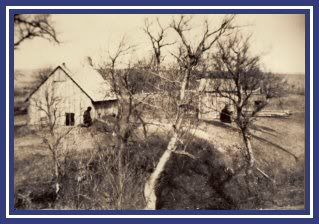
Gunfight Location |
|
At sunrise, Buck McGregg came out of the shack and scanned the ravine, then leaned his Winchester against the door casing and began washing his hands. The posse made no sound or movement. It had been impressed upon them the importance of taking the pair together. A few minutes later Cravens emerged and leaned his Winchester beside McGregg’s. This was the moment Lund was waiting for. He stood up and shouted, "You’re surrounded, throw up your hands!" That was the last thing the outlaws intended to do. Both bad men grabbed their rifles. |
Cravens dashed for the corner of the shack. In an exchange of shots he was hit by a rifle bullet and suffered a broken collar bone. For the first time in his career he had been seriously wounded. When the first shots were fired, Benjamin fired both barrels of his shotgun without effect, and then headed for home. At this point Alfred was alone at his spot in front of the shack. Alfred could see that part of the gunfire of the posse was ineffective because they had only shotguns, which could not carry the distance which lay between them and the outlaws.
McGregg crouched behind one of the buildings. Alfred was able to see the end of McGregg’s 45-90 rifle and fired through the corner of the building forcing McGregg to leave his location and seek shelter behind some long cottonwood trees in the dry creek bed. From that location McGregg did some fast hip shooting. Alfred, now alone, was laying on the side of the creek bed about 60 yards up the ravine from McGregg. The outlaw started up the ravine with the intention of out-flanking the rest of the posse. In the bottom of the ravine was a fallen tree, and McGregg hid behind it watching for some of the posse.
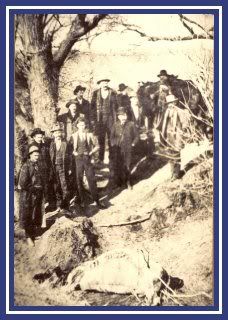
Dead Cow |
|
Alfred covered the outlaw with his rifle intending to make McGregg surrender when he got close. However, McGregg looked up and saw Alfred. Like a flash he tried to throw down on him but was to late, for Alfred let him have it. McGregg was shot in the chest, severing the arteries to his heart by the bullet. After passing through his body, the bullet hit and killed a cow standing 50 yards up the ravine.
At the same time, Ben Cravens ran into Deputy Cox and his men. Clarke's shotgun blasted and Cravens dropped in some tall grass with a load of buckshot in his side. His exact location was not known. |
McGregg was down and struggling with death. Some of the posse heard him groan and mistook him for Lund. They shouted to Lund to confirm their suspicion. Alfred, not knowing the location of Cravens, didn't answer them for fear of disclosing his location to the outlaw. However, after hearing the posse tell one another where Cravens was hiding, Alfred told them to send someone after McGregg's guns. He couldn't see McGregg and didn't know how badly he was hurt. He suspected McGregg of "playing possum". One of the posse went down and stripped the dying outlaw of his six-shooter and Winchester.
Alfred was then called to the east side of the draw to get Cravens. Not knowing the exact location of the wounded outlaw, Lund had a member of the posse fire his gun at the approximate location, causing a hand to fly up above the grass. The posse shouted for Cravens to put both hands up, but only one remained raised. They slowly ventured forth to the spot and found Cravens badly wounded and bleeding.

Buck McGregg |
|
Deputy Cox sent Alfred to town and he phoned County Attorney Dave Weir, Sheriff H.C. Master and the coroner from Ponca City. McGregg's body was taken to Blackwell Hotel and layed in state. Ben Cravens was taken to a room on the third story of the hotel at the site of present day Bank IV.
Cravens refused to talk about his dead comrade except to call him Dick, which led the officers to believe that they had killed Dan Clifton, "Dynamite Dick", but Cravens was referring to one of Buck McGregg's aliases, "Diamond Dick". He had taken this name because he had lost a diamond ring and three fingers from his left hand in a gun duel with Lincoln County officers. |
The U.S. Marshal's office in Guthrie was notified, and U.S. Marshal Nix with five deputies, one being, Frank Canton of Pawnee, arrived on the next train to Kildare. Local officers received word that a rescue was to be attempted by members of Cravens gang. So local citizens were deputized and positioned up and down that street with Winchesters. Across from the hotel was a saloon run by George Nichols. Alfred spent many nights there, covering the front entrances of the hotel. Other officers were watching the back stairway. Arriving at Blackwell, U.S. Marshal Nix was taken to view the body of the dead outlaw. When he looked at the body he said, "I don't know this man, but he isn't Dan Clifton".
Entering the upper room where Cravens was lying in bed, they recognized him at once. Cravens looking up said, "What do you want?" Frank Canton spoke up, "The name of the dead man". Cravens then began to cough and bleed from the mouth. Canton gave him a drink of water and asked him if there was anything he could do for him. "Yes, get my father here because I'm real bad and the doctors said I might not make it". Canton agreed and soon he wired Craven's father in Iowa. He arrived two days later. Death did not take Cravens and he was held at the hotel for three weeks until Kansas officers could arrive.
No rescue was made, but the town did get a little fright when two female bandits came to town. The Kildare Journal of December 11, 1896, told this story;
"Two rough and rugged females who arrived in Blackwell Monday armed to the teeth, threw the town into spasms of excitement by their strange behavior and their suspicious inquiries concerning Cravens and "Dynamite Dick", the outlaws. The females were duly arrested and searched. Certain ladies who were deputized to do the searching came near to fainting away from fright. Blackwell citizens paraded the streets armed with Winchesters, anxiously on the lookout for a raid from friends of the outlaw. The females claimed to be from Guthrie."
The identity of the dead man, for a time, was still in doubt. Some of the visitors who viewed the remains positively identified him as the notorious outlaw "Dynamite Dick", but others were just as positive that the remains lying under guard in Blackwell were those of "Skeeter Dick" or "Three Finger Jack" or some other equally desperate man. Soon Cravens spoke up and identified him as Buck McGregg.
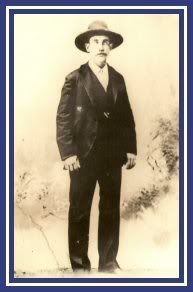
Ben Cravens |
|
Fred Gaddie arrived and recognized the horse that Cravens was riding. He also identified Cravens as the man, who in company with the dead man, held up the store of Hopper and Tweedy at Hewins, Kansas, at the time his horse was stolen. |
Deputy Sheriff Powell, of Chautaucua County, Kansas, arrived with requisition papers for Craven. Before leaving Blackwell, he requested that he be allowed to take a last look at his dead comrade, which was granted him. Accompanied by City Marshal Brewer, he walked down two flights stairs at the hotel and up the long City Marshal flight leading to the room where Buck McGregg lay cold in death. One steady look at his partner in crime, sufficed for him to say, with expression on his face that will live long in the minds of all who witnessed the sad spectacle, "That Will do, boys." He was then was placed in a closed carriage driven by J.W. Wymer with Deputy Sheriff Powell beside him, and was driven to Newkirk to take the evening train for Elgin, Kansas. In a few days, Buck McGregg's mother came from Lincoln County with two Deputy Sheriffs. She claimed the body and took it home. Alfred watched as the carriage pulled out of Blackwell carrying Cravens, not knowing their lives would cross one more time in 1912.
Because of his bravery and courage during the gunfight at Blackwell, and the killing of a "so-called" notorious outlaw, Lund's reputation grew throughout Kay County, which landed him a chance to perform his life long dream, Law Enforcement. In May of 1897, he began a 3 year term as Deputy Sheriff of Western Kay County.
During this term, in l898 he faced the most horrendous crime ever committed in Kay County since 1893, the murder and cremation of one Winfield S. Carver. In April of 1899, he was involved in the biggest manhunt in early Kay County history, involving one-time peace officer turned murderer, Clyde Maddox. Also through this term, Lund had many encounters with Buster Wainscott, small time horse thief.
In 1900 wanting to be closer to home, he gave up his Deputy Sheriff commission to become town constable of Blackwell, which he served until 1903 at which time he became City Marshal.
It was during this time that the U.S. Marshal's office issued U.S. Marshal commissions for the purpose of policing the territory better. Lund was given one of these commissions. Serving as City Marshal with the U.S. Marshal's badge, his adventures took him as far as Great Falls, Minnesota to chase down his outlaw counterparts.
In 1906, Lund declined nomination for another term, but stayed on the police force as special duty used in posses and guarding prisoners or special cases. Sometimes he would take over the night watchman's position when that peace officer was sick or out of town.
In 1911, Lund was telegraphed by the U.S. Marshal's office in Guthrie and asked if he would travel to Jefferson City, Missouri prison to identify a criminal. This man would turn out to be the same man he met in 1896 in a wooded ravine, northeast of Blackwell...Ben Cravens.
After recovering from his wounds taken from the gunfight on Lost Creek, Cravens was released to Kansas authorities, tried and convicted for a Hewins store robbery and sentenced to twenty years in the State Prison at Lansing.
On November 16, 1900, Cravens escaped, eluded a Missouri posse, stole a horse and was soon back in Osage Nation. Here he looked up an acquaintance of his that he had met while in prison, a young horse thief from Kingfisher, Bert Welty.
On March 18, 1901, Cravens and Welty dressed as homesteaders, robbed the B.F. Swartz & Company store at Red Rock. During the robbery a postmaster named Alvin Bateman was killed. When escaping Welty was shot by accident or by purpose by Cravens and left for dead. Cravens was tracked to the home of Isom Cunningham, northeast of Pawnee. When a posse tried to confront him, he shot and killed Deputy Tom Johnson, then escaped in the bottoms of Black Bear Creek.
After this encounter there was no trace of Cravens, who became the most talked about outlaw in the southwest. His reward was set at $10,000 with $6,000 of it offered by the Anti-Horse Thief Association. Stories soon surfaced of him in Texas, Arizona and New Mexico, but none of these panned out.
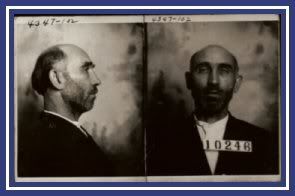
Charles Maust Prison Picture
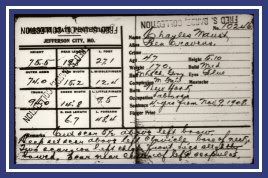
Charles Maust Prison Record |
The years passed, and the outlaw was forgotten. Then, up in Missouri, a man named Charles Maust was arrested for livestock theft and sentenced to 4 years in the state penitentiary at Jefferson City. Maust had appeared from nowhere in the small town in Oregon in 1902. For 6 years he worked as a farm laborer in the vicinity, married a local girl, and was considered a respectable citizen, until he got caught stealing hogs. |
In March 1911, the Missouri prison got a new barber. A few days later he shaved a face that had been
familiar to him while barbering at Lansing and informed the officials that Charles Maust was Ben Cravens.
J.H. Livingston, superintendent of the Bertillon system at the penitentiary, obtained Cravens record from Lansing. The high receding forehead, positively hairless now, and was scarred at the left brow proved to make Maust a good look-alike for Cravens. Alfred Lund arrived at Jefferson City and identified Cravens by the scars from his wounds recieved at Blackwell in 1896. Guard Abe Haucke arrived later and said that he was the convict who had escaped from Lansing in 1900. Cravens, or Charles Maust, was released to Oklahoma authorities and transported on the next train to Guthrie.
In January of 1912, Cravens went on trial in the United District Court at Guthrie for the murder of Postmaster Alvin Bateman. Al Jennings, a former train robber who had been pardoned bt President Theodore Roosevelt and resumed his law practice, defended him. It was one of the most sensational hard fought cases in the states history, with the government presenting the greatest array of witnesses ever seen in a federal court.
Cravens was the first arraigned in court on January 4, but because of how the indictment was worded, merely saying "Ben Cravens," a new indictment had to be returned by grand jury. On January 16, Cravens was re-arraigned in federal court, and the new indictment read, "Ben Cravens alias Charles Maust." There he pleaded not guilty. When taken into the court room, spectators who saw the prisoner a week ago could hardly recognize him. Face swollen, eyes almost shut and constanstly watering, a changed man in appearance and action. Physicians who visited him in jail stated his eyes and breast were probably affected by a large carbuncle on his arm. However, it was the opinion of many that someone slipped him "dope" of some kind which caused his face and eyes to become swollen.
It was first reported to the court that his condition wouldn't permit the walk from prison to the federal building. Judge Cotteral ordred the deputies to devise a means by which to bring the prisoner. The deputies took the prisoner from his cot, pushed him into his clothes, wrapped him in a huge overcoat and bundled him into the presence of the court. After pleading not guilty he was ordered to remain in the custody of the Marshal's office. Following this statement, Judge Cotteral ordered the United States Marshal to investigate the rumor that Maust had used some kind of drug or an application to distort and change his face in order that positive identification would be almost impossible. He ordered further, that the watch at the jail be made more secure, if possible, and whether or not the prisoner had received some kind of drug from the outside; heretofore they should take every precaution that he does not do it in the future, stating caution that it would do no harm and might do a great deal of good.
The trial was postponed for a week, thus letting the prisoner's swelling go away. Pictures were published in the Oklahoman showing Ben Cravens in Lansing and Charles Maust in Jefferson City, which showed a perfect likeness. But the chief difference between Ben Cravens of 15 years ago and the man that was in jail accused of being Cravens was that the prisoner was totally bald, while the notorious outlaw during the time he was working in Oklahoma, had a thick, heavy head of hair. He wore a mustache the greater portion of the time, and was known this way. The prosecutions best luck in indentifying Cravens would be in his battle wounds.
On January 20, the case was finally brought to trial. Maust was on the scene bright and early, attired in the same brown suit given him prior to his release from the Missouri penitentiary at Jefferson City. Since he had a record for escaping, if he was Ben Cravens, the prisoner was brought from the jail securely manacled and guarded by Deputy Marshal Jack Langston and Dave Hadden. In the courtroom, the handcuffs were removed, but a strong guard was kept on over the prisoner, who sat at a desk to the right of the bar. The effects of the breaking out on his face had almost disappeared. He appeared absolutely at ease, talking frequently with his guards and more than once he smiled.
Only one day was sufficient to empanel the jury. The United Stated Attorney John Embry read the indictment and outlined the prosecution in a speech. The government will base it's prosecution upon an unbroken chain of evidence, which will show the defendent is none other than the notorious outlaw; Ben Cravens. Attorney Al Jennings said he would introduce evidence to show that it has been a simple case of mistaken identity.
The next day the prosecution called the following witnesses; Dr. W.T. Cartwright, Lansing Penitentiary physician, Bert Welty, Mrs. Ora Welty, Gen. Frank Canton of the State Militia and Alfred Lund. Each one of these positively identified the prisoner as Ben Cravens.
The trial was one of the longest ones in the state's history, with the prosecution bringing in over 141 witnesses, most of them concerning indentification of the prisoner. On January 26, the case was given to the jury, and informed them that while there was a modification of killing known as manslaughter such as the case had couldn't be considered, as defense had introduced no evidence and in no way had attempted to refute testimony and argument by the prosecution to establish the malice of the crime. He instructed them under the law, there were only three choices, acquittal, conviction with no modification, which would mean hanging by the neck until dead, and conviction with the death penalty stricken out.
It took the jury only five hours to reach a vedict in the case. Handcuffed to Deputy Marshal Goff, as on every previous journey from the federal jail to the courtroom, and guarded by several other marshal's, the prisoner reached the courtroom two minutes ahead the jury. With the same apparently careless smile on his face, but with shoulders dropped more than usual, a more pronounced shuffle to his walk, he passed to a spot directly in front of the judge, where Deputy Marshal Chris Madsen removed the handcuffs and bid the prisoner to be seated in the same chair he had occupied throughout the trial. Soon the jury was called in and the court clerk read the verdict, finding him guilty and recommending the death penalty not be inflicted. As the clerk finished reading the verdict, Cravens spoke up loudly saying, "It's hanging, ain't it?" When informed otherwise, he said, "That's better."
On January 30, Cravens was brought before Judge Cotteral, who sentenced him to life in prison at Leavenworth, Kansas. When he returned to the federal jail in Guthrie, Cravens gave his fine brown suit which he had worn during the trial and another good suit to a fellow prisoner, Dave Sears, who was awaiting trial on charges of robbing a train in the Osage country. Cravens took the clothes formerly worn by Sears. He presented a dilapidated appearance dressed in blue overalls with a rugged old coat and a black, greasy slouch hat full of holes. Wearing the Oregon boot and securely handcuffed, with Chief Deputy U.S. Marshal Chris Madsen and James Baxter and Dave Haddon, both deputies as guards, Cravens was transported by rail to Leavenworth.
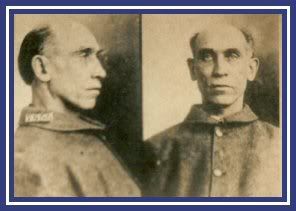
Ben Cravens in Leavenworth |
|
Arriving at Kansas City, Deputy Warden Mackey of the federal prison was waiting. He wired the prison to send a wagon to the city to convoy the prisoner to the penitentiary. Cravens was soon waiting at the big gates for the captian of the guards to take him in charge. The prisoner was searched and his personal property taken away. The Deputy Warden's clerk asked his name, age and personal questions, making a record of his personal property. He still persisted that he wasn't Ben Cravens, but that his name was Charles Maust, and the clerk wrote it down. |
The regular dinner for prisoners was over when they arrived, and as there had been no time to get dinner in Kansas City, a special one was prepared for Cravens, who appeared to have a good appetite. Following dinner he was taken to the office of the record clerk, where his first photograph was taken in the clothing he wore on his arrival. He was then sent to the bath house, where he obtained a much needed bath and a suit of prison clothes, including underwear and shoes. After the uniform had been donned, he was again taken to the office of the record clerk where he again was photographed in prison costume, and his Bertillon measurements and fingerprints taken. Before leaving to his jail cell, he was given his prison number... 19864.
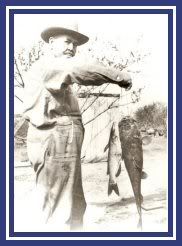
Alfred Lund after Retirement |
|
in 1913, Alfred took over the job as detective for the Santa Fe Railroad. He worked the rail until 1920, then operated a fruit orchard north of town. This fruit orchard was the mainstay for alot of families in Blackwell during the Depression. The families would buy the fruit to operate the fruit stands along the roadway. |
By the late 1930's Alfred went into retirement and spent most of his time sitting in the fire department playing checkers. Alfred always had a story to tell, and was interviewed in 1933 and 1940 by a local reporter from the Blackwell Tribune.
In 1945, Alfred's health began to fail him, and he passed away the following year, April 23, 1946. He was buried in Conway Springs, Kansas beside his father.
Ben Cravens, alias Charles Maust, lived to a ripe old age, outliving all the peace officers that tracked him in the old Oklahoma Territory days. Due to ill health, he was transferred on October 17, 1936 to the Medical Center for Federal Prisoners at Springfield, Missouri. He died on September 19, 1950, denying his identity to the end.
|












